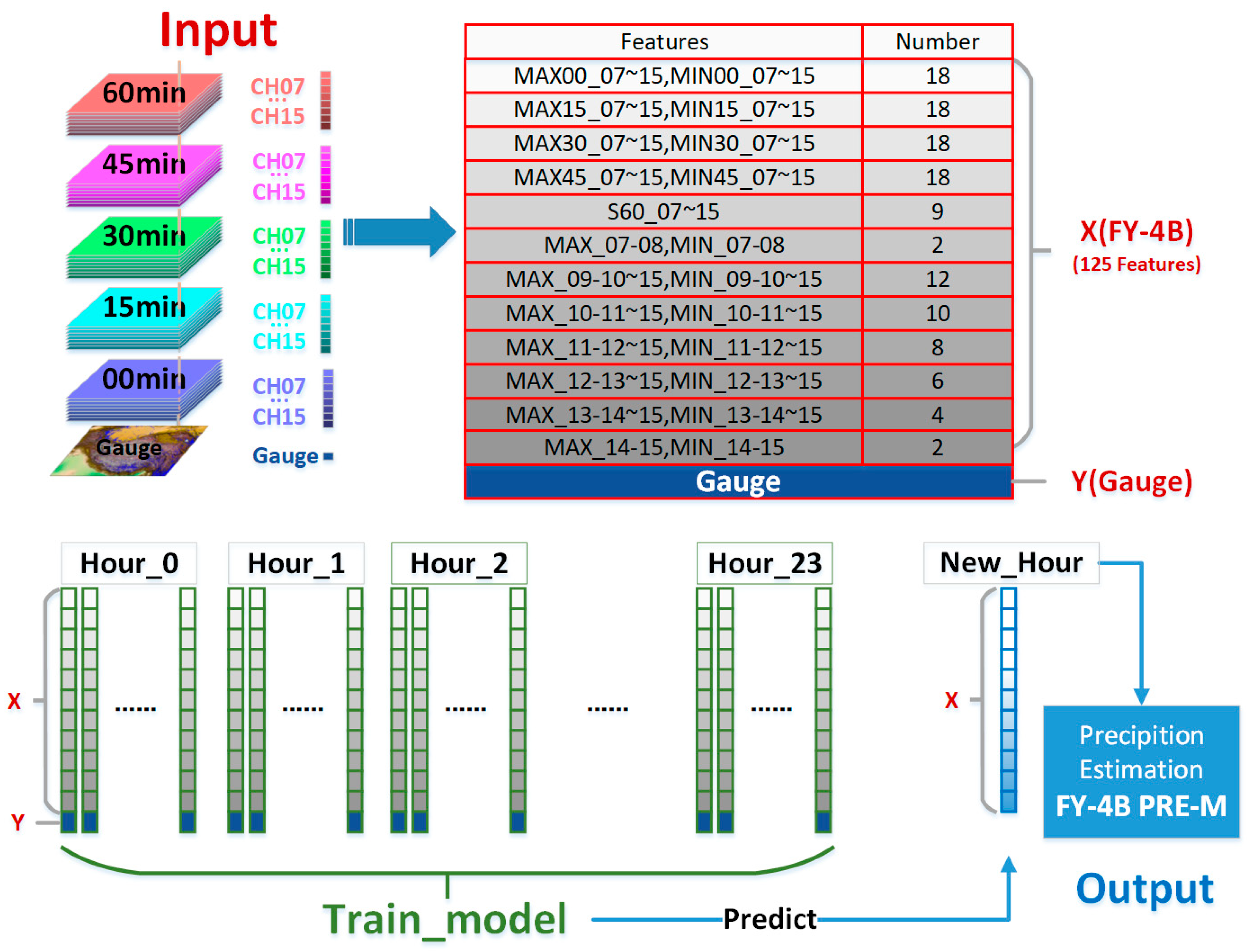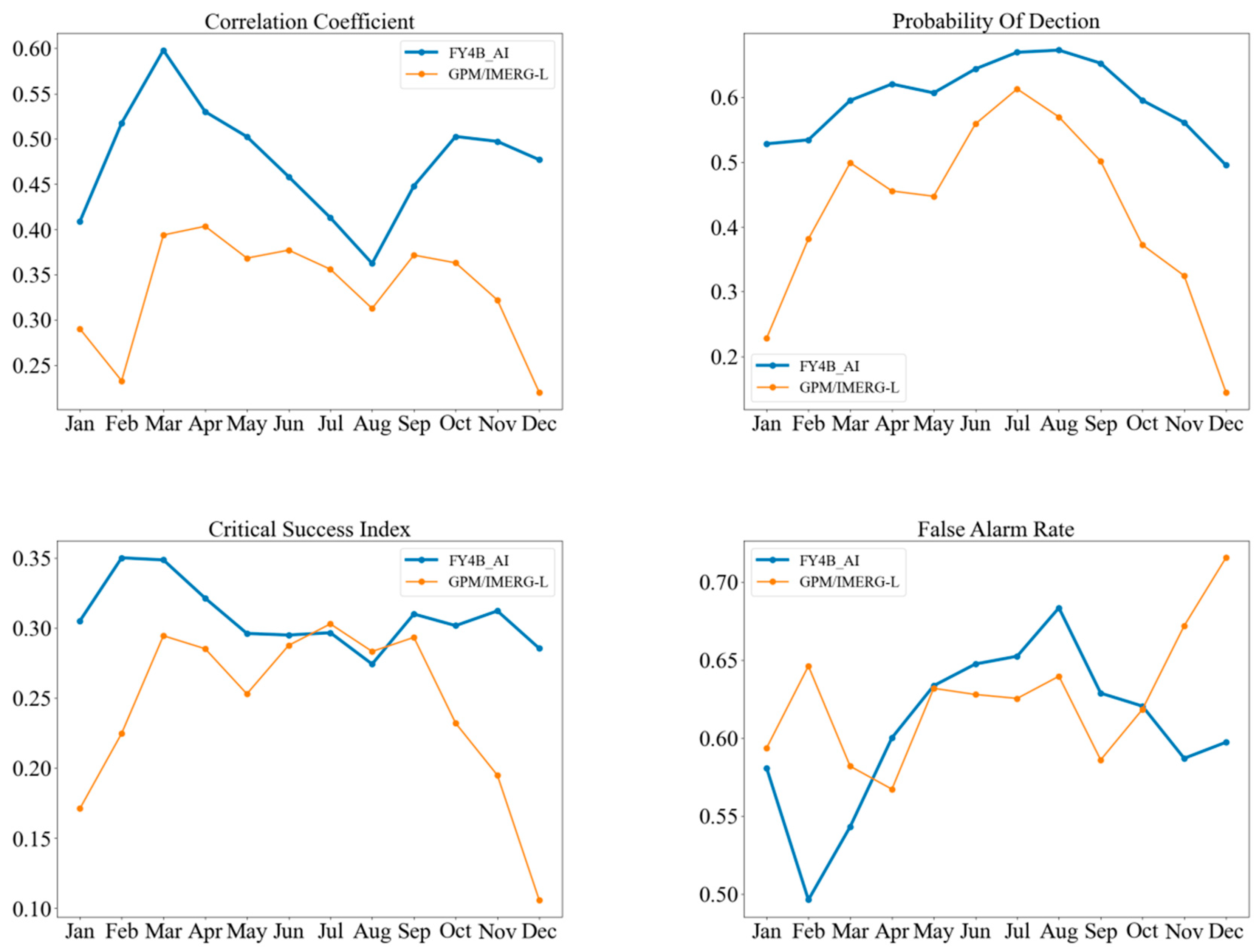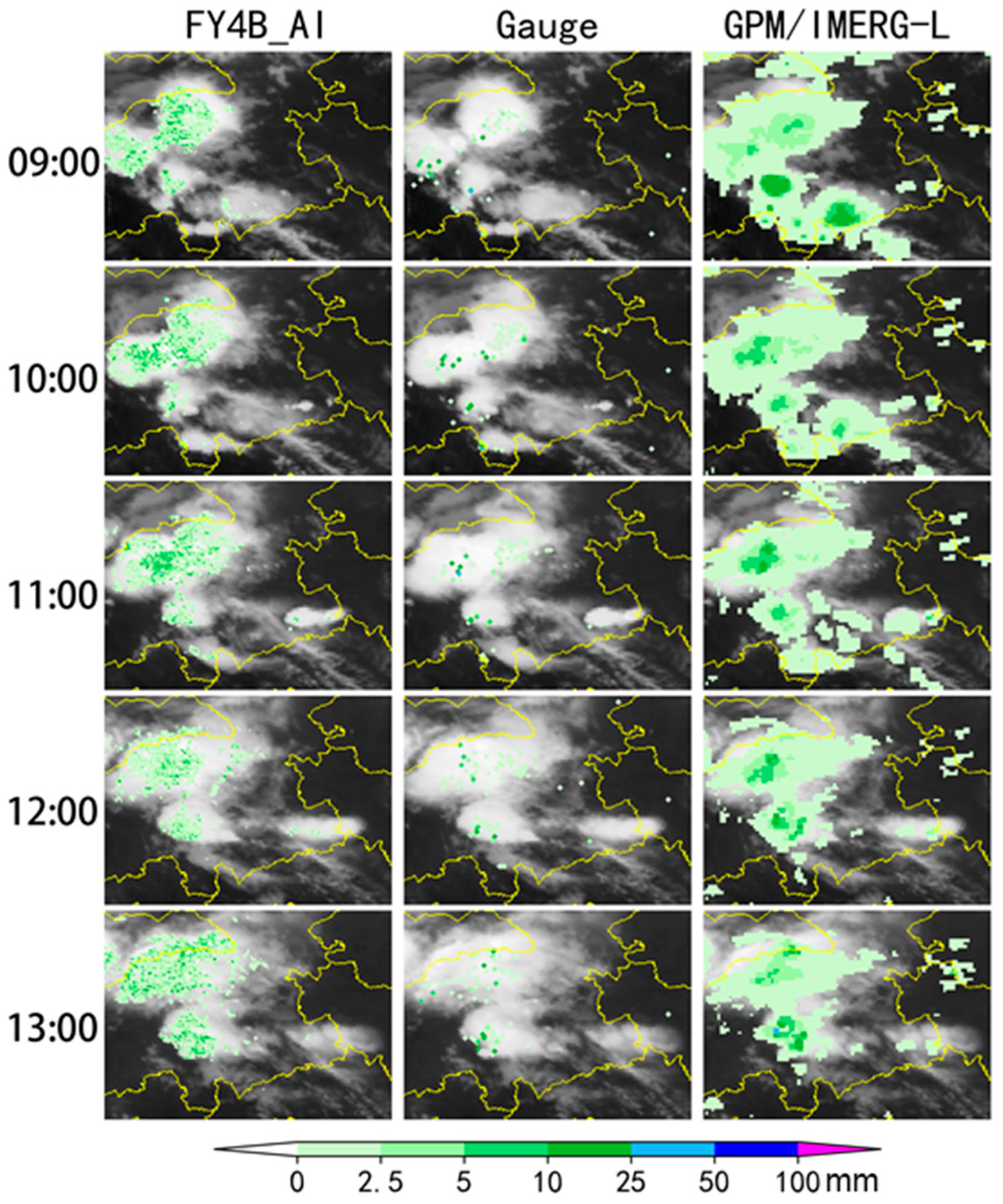Artificial Intelligence-Based Precipitation Estimation Method Using Fengyun-4B Satellite Data
Abstract
:1. Introduction
2. Verification Area and Data
2.1. Verification Area
2.2. FY-4B/AGRI Data
2.3. Ground-Based Rain Gauge Precipitation Data in Mainland China
2.4. GPM/IMERG-L Dataset
3. Research Methods
3.1. Spatiotemporal Matching Method for the Evaluation of the Precision of Satellite-Derived Precipitation Estimates
3.2. Satellite Precipitation Estimation Product Evaluation Methods
3.3. Intelligent Precipitation Estimation Algorithm Based on Multi-Temporal Satellite Data
3.3.1. Feature Construction for FY-4B_AI Satellite Precipitation Estimation
3.3.2. Precipitation Estimation Algorithm Model
4. Accuracy Verification of Precipitation Estimation Products from Meteorological Satellites Based on Artificial Intelligence
4.1. Overall Accuracy Assessment
4.2. Monthly Variation Characteristics of Satellite-Derived Precipitation Accuracy
4.3. Spatial Variation Characteristics of Satellite-Derived Precipitation Accuracy (Northwest Dry Region/Southeast Humid Region)
5. Application Evaluation of Strong Weather Events
5.1. Application Evaluation of the Strong Weather Event in Guizhou Province on 18 June 2023 (Southeast Humid Region)
5.2. Application Evaluation of the Strong Weather Event in Inner Mongolia on 20 July 2023 (Northwest Dry Region)
6. Discussions
7. Conclusions
- (1)
- The comprehensive accuracy assessment demonstrated that six of the eight evaluation indices exhibited superior performance in FY-4B_AI compared to GPM/IMERG-L, namely, MAE, RMSE, RE, CC, POD, and CSI. Of particular note is the significantly lower RE of FY-4B_AI in comparison to GPM/IMERG-L.
- (2)
- The monthly distribution of precipitation accuracy revealed that a number of indicators displayed distinctive annual variation characteristics. The FY-4B_AI model displays superior performance in MAE, RMSE, CC, and POD. It can be observed that MAE and RMSE are larger during the summer half-year and smaller during the winter half-year. This suggests a correlation between these features and seasonal variations in precipitation. Furthermore, the CC and POD demonstrate that the FY-4B_AI model outperforms GPM/IMERG-L, although the correlation with the season is not evident. The ME and RE of the FY-4B_AI are superior to those of the GPM/IMERG-L in the context of winter precipitation.
- (3)
- The spatial distribution of precipitation accuracy demonstrates that FY-4B_AI outperforms GPM/IMERG-L in seven out of eight evaluation indices across both the northwest dry region and the southeast humid region. Of particular note is the significantly lower RE exhibited by FY-4B_AI in comparison to GPM/IMERG-L.
Author Contributions
Funding
Data Availability Statement
Acknowledgments
Conflicts of Interest
References
- Xu, R.; Tian, F.Q.; Yang, L.; Hu, H.; Lu, H.; Hou, A. Ground validation of GPM IMERG and TRMM 3B42V7 rainfall products over the southern Tibetan Plateau based on a high-density rain gauge network. J. Geophys. Res. Atmos. 2017, 122, 910–924. [Google Scholar] [CrossRef]
- Zambrano-Bigiarini, M.; Nauditt, A.; Birkel, C.; Verbist, K.; Ribbe, L. Temporal and spatial evaluation of satellite-based rainfall estimates across the complex topographical and climatic gradients of Chile. Hydrol. Earth Syst. Sci. 2017, 21, 1295–1320. [Google Scholar] [CrossRef]
- Baroentti, A.; Acquaotta, F.; Fratianni, S. Rainfall variability from a dense rain gauge network in north-west Italy. Clim. Res. 2018, 75, 201–213. [Google Scholar] [CrossRef]
- Tang, G.Q.; Behrangi, A.; Long, D.; Li, C.; Hong, Y. Accounting for spatiotemporal errors of gauges: A critical step to evaluate gridded precipitation products. J. Hydrol. 2018, 559, 294–306. [Google Scholar] [CrossRef]
- Hou, A.Y.; Kakar, R.K.; Neeck, S.; Azarbarzin, A.A.; Kummerow, C.D.; Kojima, M.; Oki, R.; Nakamura, K.; Iguchi, T. The global precipitation measurement mission. Bull. Am. Meteorol. Soc. 2014, 95, 701–722. [Google Scholar] [CrossRef]
- Huffman, G.J.; Adler, R.F.; Bolvin, D.T.; Gu, G.; Nelkin, E.J.; Bowman, K.P.; Hong, Y.; Stocker, E.F.; Woleff, D.B. The TRMM Multisatellite Precipitation Analysis (TMPA): Quasi-global, multiyear, combined-sensor precipitation estimates at fine scale. J. Hydrometeorol. 2007, 8, 38–55. [Google Scholar] [CrossRef]
- Zhang, M.; Lu, N.; Gu, S.; Zhang, W. Temperature-sounding Microwave Channels for FY-3(02). J. Appl. Meteorol. Sci. 2012, 23, 223–230. (In Chinese) [Google Scholar]
- Grody, N.C. Classification of snow cover and precipitation using the Special Sensor Microwave Imager. J. Geophys. Res. Atmos. 1991, 96, 7423–7435. [Google Scholar] [CrossRef]
- Kummerow, C.; Barnes, W.; Kozu, T.; Shiue, J.; Simpson, J. The tropical rainfall measuring mission (TRMM) sensor package. J. Atmos. Ocean. Technol. 1998, 15, 809–817. [Google Scholar] [CrossRef]
- Li, W.; Chen, Y.; Zhu, Y.; Zhao, B. Retrieval of rain over land by using TRMM/TMI measurements. Acta Meteorol. Sin. 2001, 59, 591–601. (In Chinese) [Google Scholar]
- Li, X.; Yang, H.; You, R.; Zhao, F.; Qiao, Y. Remote sensing typhoon Songda’s rainfall structure based on Microwave Radiation Imager of FY-3B satellite. Chin. J. Geophys. 2012, 55, 2844–2853. (In Chinese) [Google Scholar]
- Li, P.; Xu, Z.; Ye, C.; Ren, M.; Chen, H.; Wang, J.; Song, S. Assessment on IMERG V06 Precipitation Products Using Rain Gauge Data in Jinan City, Shandong Province, China. Remote Sens. 2021, 13, 1241. [Google Scholar] [CrossRef]
- Xie, S.; Sun, X.; Zhang, S.; Xiong, Z.; Wei, X.; Cui, C. Precipitation forecast correction in South China based on SVD and machine learning. J. Appl. Meteor. Sci. 2022, 33, 293–304. (In Chinese) [Google Scholar] [CrossRef]
- Zhou, K.; Zheng, Y.; Han, L.; Dong, W. Advances in Application of Machine Learning to Severe Convective Weather Monitoring and Forecasting. Meteorol. Mon. 2021, 47, 274–289. (In Chinese) [Google Scholar]
- Li, D.; Lin, W.; Liu, Q.; Feng, H.; Hu, S.; Wang, Z. Application of machine learning to statistical evaluation of artificial rainfall enhancement. J. Appl. Meteor. Sci. 2024, 35, 118–128. (In Chinese) [Google Scholar]
- Zhang, Y.; Zhang, Y.; Zhai, D.; Liu, B.; Zhou, G. Thoughts on application and improvement of deep learning in severe precipitation nowcasting technology. Torrential Rain Disasters 2022, 41, 506–514. (In Chinese) [Google Scholar]
- Chen, Y.; Cao, Y.; Sun, J.; Fu, J.; Dong, Q.; Yu, C.; Liu, C.; Tang, J.; Guo, Y. Progress of Fine Gridded Quantitative Precipitation Forecast Technology of National Meteorological Centre. Meteorol. Mon. 2021, 47, 655–670. (In Chinese) [Google Scholar]
- Fang, W.; Shen, L.; Zou, L.; Pang, L. Extrapolation method of precipitation nowcasting radar echo based on GCA-ConvLSTM prediction network. Torrential Rain Disasters 2023, 42, 427–436. (In Chinese) [Google Scholar]
- Moraux, A.; Dewitte, S.; Cornelis, B.; Munteanu, A. Deep learning for precipitation estimation from satellite and rain gauge measurements. Remote Sens. 2019, 11, 2463. [Google Scholar] [CrossRef]
- Kidd, C.; Matsui, T.; Ringerud, S. Precipitation retrievals from passive microwave cross-track sensors: The precipitation retrieval and profiling scheme. Remote Sens. 2021, 13, 947. [Google Scholar] [CrossRef]
- Liu, N.; Ren, S.; Jiang, J.; Qin, D.; Han, B. AI-based estimation of precipitation in the Tibetan Plateau using multi-temporal FY-4A satellite data. Int. J. Remote Sens. 2023, 44, 6523–6547. [Google Scholar] [CrossRef]
- Xian, D. Fengyun-4B. Appl. Satell. 2021, 7, 4. (In Chinese) [Google Scholar] [CrossRef]
- Huffman, G.J.; Stocker, E.F.; Bolvin, D.T.; Nelkin, E.J.; Tan, J. GPM IMERG Late Precipitation L3 Half Hourly 0.1 degree x 0.1 degree V06; Goddard Earth Sciences Data and Information Services Center (GES DISC): Greenbelt, MD, USA, 2019. [Google Scholar] [CrossRef]
- Wang, J.; Wang, H.; Hong, Y. Comparison of satellite-estimated and model-forecasted rainfall data during a deadly debris-flow event in Zhouqu, Northwest China. Atmos. Ocean. Sci. Lett. 2016, 9, 139–145. [Google Scholar] [CrossRef]
- He, S.; Wang, J.; Wang, H. Hindcast study of “6.18” Mentougou debris-flow event based on satellite rainfall and WRF forecasted rainfall. Chin. J. Atmos. Sci. 2018, 42, 590–606. (In Chinese) [Google Scholar]
- Zhang, L.; Kang, Y.; Yue, Q.; Tang, J.; Xu, J.; Wang, J.; Hao, Z. Analysis of the applicability of various satellite-based precipitation in the source region of Yellow River. Yellow River 2021, 43, 29–33. (In Chinese) [Google Scholar]
- Zhao, B.; Hudak, D.; Rodriguez, P.; Mekis, E.; Brunet, D.; Eckert, E.; Melo, S. Assessment of IMERGv06 Satellite Precipitation Products in the Canadian Great Lakes Region. J. Hydrometeorol. 2023, 24, 1017–1037. [Google Scholar] [CrossRef]







| Band | Central Wavelength (μm) | Bandwidth (μm) | Spatial Resolution (km) | Main Purpose |
|---|---|---|---|---|
| 1 | 0.47 | 0.45~0.49 | 1 | Aerosol |
| 2 | 0.65 | 0.55~0.75 | 0.5 | Fog, cloud |
| 3 | 0.825 | 0.75~0.90 | 1 | Vegetation |
| 4 | 1.379 | 1.371~1.386 | 2 | Cirrus |
| 5 | 1.61 | 1.58~1.64 | 2 | Cloud, snow |
| 6 | 2.25 | 2.10~2.35 | 2 | Cirrus, aerosol |
| 7 | 3.75 | 3.50~4.0 (high) | 2 | Fire |
| 8 | 3.75 | 3.50~4.0 (low) | 4 | Land surface |
| 9 | 6.25 | 5.80~6.70 | 4 | Upper-level water vapour |
| 10 | 6.95 | 6.75~7.15 | 4 | Mid-level water vapour |
| 11 | 7.42 | 7.24~7.60 | 4 | Low-level water vapour |
| 12 | 8.55 | 8.3~8.8 | 4 | Cloud |
| 13 | 10.80 | 10.30~11.30 | 4 | Surface temperature |
| 14 | 12.00 | 11.50~12.50 | 4 | Surface temperature |
| 15 | 13.3 | 13.00~13.60 | 4 | Clouds and water vapour |
| Index | FY-4B_AI | GPM/IMERG-L |
|---|---|---|
| ME | −0.88 | −0.80 |
| MAE | 1.67 | 1.92 |
| RMSE | 3.68 | 4.07 |
| RE | 17.72% | 26.28% |
| CC | 0.44 | 0.36 |
| POD | 61.84% | 47.31% |
| FAR | 62.85% | 62.21% |
| CSI | 0.30 | 0.27 |
| Index | FY-4B_AI | GPM/IMERG-L |
|---|---|---|
| ME | −0.73 | −0.79 |
| MAE | 1.24 | 1.37 |
| RMSE | 2.64 | 2.83 |
| RE | −3.78% | −20.73% |
| CC | 0.35 | 0.32 |
| POD | 59.05% | 38.25% |
| FAR | 72.89% | 65.45% |
| CSI | 0.23 | 0.22 |
| Index | FY-4B_AI | GPM/IMERG-L |
|---|---|---|
| ME | −0.91 | −0.80 |
| MAE | 1.76 | 2.03 |
| RMSE | 3.85 | 4.27 |
| RE | 21.95% | 35.53% |
| CC | 0.45 | 0.36 |
| POD | 62.39% | 49.09% |
| FAR | 60.10% | 61.66% |
| CSI | 0.32 | 0.27 |
| Index | FY-4B_AI | GPM/IMERG-L |
|---|---|---|
| ME | −0.843 | −0.288 |
| MAE | 1.951 | 2.591 |
| RMSE | 4.988 | 6.029 |
| RE | 142.013% | 255.706% |
| CC | 0.438 | 0.307 |
| POD | 62.129% | 56.709% |
| FAR | 60.962% | 60.726% |
| CSI | 0.315 | 0.302 |
| Index | FY-4B_AI | GPM/IMERG-L |
|---|---|---|
| ME | −0.483 | −0.536 |
| MAE | 0.599 | 0.598 |
| RMSE | 2.556 | 2.570 |
| RE | −39.461% | −62.465% |
| CC | 0.012 | 0.006 |
| POD | 20.000% | 21.111% |
| FAR | 99.687% | 99.339% |
| CSI | 0.003 | 0.006 |
Disclaimer/Publisher’s Note: The statements, opinions and data contained in all publications are solely those of the individual author(s) and contributor(s) and not of MDPI and/or the editor(s). MDPI and/or the editor(s) disclaim responsibility for any injury to people or property resulting from any ideas, methods, instructions or products referred to in the content. |
© 2024 by the authors. Licensee MDPI, Basel, Switzerland. This article is an open access article distributed under the terms and conditions of the Creative Commons Attribution (CC BY) license (https://creativecommons.org/licenses/by/4.0/).
Share and Cite
Liu, N.; Jiang, J.; Mao, D.; Fang, M.; Li, Y.; Han, B.; Ren, S. Artificial Intelligence-Based Precipitation Estimation Method Using Fengyun-4B Satellite Data. Remote Sens. 2024, 16, 4076. https://doi.org/10.3390/rs16214076
Liu N, Jiang J, Mao D, Fang M, Li Y, Han B, Ren S. Artificial Intelligence-Based Precipitation Estimation Method Using Fengyun-4B Satellite Data. Remote Sensing. 2024; 16(21):4076. https://doi.org/10.3390/rs16214076
Chicago/Turabian StyleLiu, Nianqing, Jianying Jiang, Dongyan Mao, Meng Fang, Yun Li, Bowei Han, and Suling Ren. 2024. "Artificial Intelligence-Based Precipitation Estimation Method Using Fengyun-4B Satellite Data" Remote Sensing 16, no. 21: 4076. https://doi.org/10.3390/rs16214076
APA StyleLiu, N., Jiang, J., Mao, D., Fang, M., Li, Y., Han, B., & Ren, S. (2024). Artificial Intelligence-Based Precipitation Estimation Method Using Fengyun-4B Satellite Data. Remote Sensing, 16(21), 4076. https://doi.org/10.3390/rs16214076





